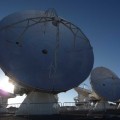The Harvard-Smithsonian Center for Astrophysics has been selected by the National Science Foundation as the recipient of a 12-meter (39-foot) radio antenna designed for submillimeter-wavelength astronomy. The ALMA Vertex Prototype Antenna was one of three antennas built as prototypes for the Atacama Large Millimeter Array, a 66-dish radio observatory currently being constructed in Chile.
The Harvard-Smithsonian Center for Astrophysics will operate the antenna in collaboration with the Academia Sinica Institute of Astronomy and Astrophysics in Taiwan. The donation continues s long-standing and fruitful partnership between the Center for Astrophysics and ASIAA, established with the construction and operation of the Submillimeter Array on Mauna Kea, Hawaii.
The Center for Astrophysics is a world leader in the technology for building receivers at submillimeter wavelengths—a little-explored region of the electromagnetic spectrum between visible light and radio waves. With submillimeter antennas, astronomers can study diverse cosmic environments like cold interstellar gas clouds, dusty star-forming regions and the cores of giant elliptical galaxies.
The prototype antenna will link with other submillimeter observatories to provide an extremely sharp, high-resolution look at targets of interest, in a process known as Very Long Baseline Interferometry. It will also conduct single-dish observations.
The antenna will be moved to a new location which has yet to be selected. Submillimeter astronomy requires a site with an exceptionally dry atmosphere overhead, which is usually obtained at high-altitude locations with prevailing cold temperatures. For this reason, the partners are considering a National Science Foundation site in Greenland known as Summit Station.





